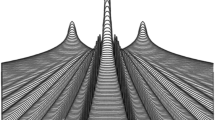Abstract
Volume II of The Feynman Lectures on physics is primarily devoted to explicating classical electromagnetism. Quantum theory arises in just one lecture, 15-5, entitled “The vector potential and quantum mechanics”. He emphasizes a remarkable conceptual change that the classically central notion of force “becomes quite secondary—if it is there at all” in quantum physics. He wishes to demonstrate, with as little quantum theory apparatus as possible, how the quantum notion of a wave function’s phase carries information about the classical force. To that end, he uses the Aharonov–Bohm effect in two thought experiments involving a two-slit electron interference pattern and two different configurations of magnetic field. Here I review Feynman’s argument with the benefit of more specificity about the quantum calculation than Feynman wished to give. Tiwari (Phys Rev Lett 113:158901, 2014, Quantum Stud.: Math. Found. 4:1 2017) recently criticized Feynman’s lecture for not providing a classical explanation of the Aharonov–Bohm effect. I believe this criticism is unwarranted because Feynman never set out to do that. What Feynman does is consider a two-slit interference experiment for an electron with a special magnetic field configuration, and he shows in this case that, when the magnetic field is turned on, the interference pattern on the detection screen shifts by the same distance as the classical trajectories emanating from the slit shift due to the magnetic force. That there is such an example, although unique, which suggests how the quantum phase may be connected to the classical trajectory, appears to be all that Feynman wishes to convey. If Feynman’s presentation is to be faulted, it is that this example is unique, that reasonable extensions of this thought experiment do not show this connection.



Similar content being viewed by others
Notes
The figures given here are from the free download web site for The Feynman Lectures, http://www.feynmanlectures.caltech.edu. These differ from the figures given in Feynman et al. [2] in that the labeling for trajectories 1 and 2 are reversed, correcting an error in Feynman et al. [2]: certain equations in Feynman et al. [2] also have their signs reversed in the online version. A footnote in both sources says the magnetic field comes out of the figure: this is the \(-z\)-direction, if the screen is at \(y=+L\), and we use a right-handed coordinate system. Moreover, the footnote in the web site, but not in Feynman et al. [2], declares that the particle is an electron, so we shall take the particle charge \(q=-e\), where \(e>0\). I shall use Feynman’s notation, with additions (such as e) when needed.
One can readily see that the contribution to the phase difference of the trajectories from source to slits is almost equal to that of the trajectories from slits to screen. The whole phase difference, \(\frac{q}{\hbar }\mathcal{F}\), is given by \(\frac{q}{\hbar }\) multiplying the integral of \(\mathbf{A}\) along the path from source to slit 1 to screen, and backwards from screen to slit 2 to source. But, a path segment parallel to the x-axis—label it 3—which goes through the middle of the solenoid, ending on paths 1 and 2, has zero value of the path integral since the path is orthogonal to \( \mathbf{A}\) there. Thus, the path which goes from the source, along 1 then cuts along 3 and returns to the source backward along 2 contains within it flux \(\mathcal{F}/2\), as does the triangular path which starts from near the slit along path 1, goes to the screen, and returns backward along 2, and then along 3 to its beginning.
References
Khatua, P., Bansal, B., Shahar, D.: Phys. Rev. Lett. 112, 010403 (2014)
Feynman, R.P., Leighton, R.B., Sands, M.: The Feynman lectures on physics, vol. 2, Chap. 15. Addison-Wesley, Reading (1964)
Tiwari, S.C.: Quantum Stud.: Math. Found. 4, 1 (2017)
Tiwari, S.C.: Phys. Rev. Lett. 113, 158901 (2014)
Pearle, P., Rizzi, A.: Phys. Rev. A 95, 052123 (2017)
Acknowledgements
I would like to thank Lev Vaidman for suggesting this note, and for providing valuable comments.
Author information
Authors and Affiliations
Corresponding author
Rights and permissions
About this article
Cite this article
Pearle, P. Feynman’s lecture utilizing the Aharonov–Bohm effect. Quantum Stud.: Math. Found. 5, 391–398 (2018). https://doi.org/10.1007/s40509-017-0124-z
Received:
Accepted:
Published:
Issue Date:
DOI: https://doi.org/10.1007/s40509-017-0124-z




